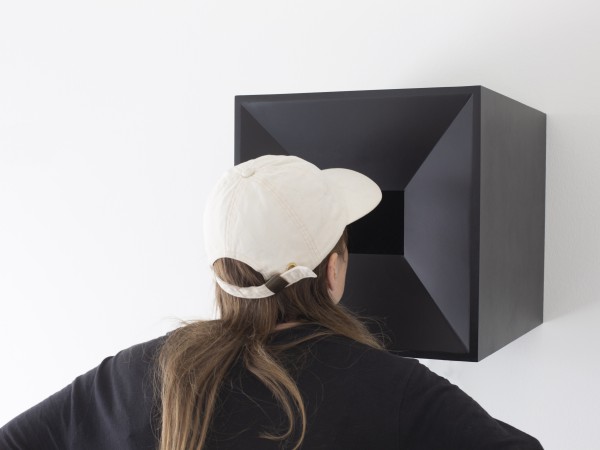You Could Not Even Take a Picture
2021, Audioloop 3 Min., Rom Player, Power Supply, Amplifier, Microwave Detector, Light Organ, Transducer, LED, MDF, Nylon, 36 x 36 x 46 cm
Exhibition Views: Bernd Oppl Crossing Europe, Lentos Featured Artist 2021
The boundaries between physical and virtual space often seemed to blur in the course of the pandemic since spring 2020. In some places, home office or online teaching transformed the home into a workplace, the room in a shared flat into a seminar room. Those who didn’t have a private yacht or even a spacecraft at their disposal were thrown back on their own living situation in case of doubt, and many an executive position soon wondered aloud whether the physical learning or workspace was still really necessary. The cinema, in contrast to the streaming industry, is certainly not one of the winners of these times. A physical space (the cinema) that only serves to pave the way for a virtual space (the film) has a hard time in the pandemic. This function should also be taken over by one’s own four walls, with the help of a laptop or cell phone.
In YOU COULD NOT EVEN TAKE A PICTURE Bernd Oppl gives the stage to a special cinema. Through a shaft, viewers look inside a box at an architecture that is only illuminated for a few moments. At first glance, not much can be made out: Ceiling, walls, floor, seat covers – all black. A space that seems to disappear completely to serve exclusively the space of the film. The concept of this “Invisible Cinema” goes back to discussions between filmmaker Peter Kubelka and some architects in the late 1950s. Kubelka saw the cinema as a seeing and hearing machine that acts as a mediator between the director and the audience. The attempt to realize such a cinema space in Vienna failed for the time being, but succeeded in 1970 in New York at the newly founded Anthology Film Archives with the support of filmmaker and author Jonas Mekas. It is his voice that viewers hear when they look into Bernd Oppl’s model. The flickering spotlights that briefly illuminate the miniature cinema are controlled by the amplitudes of the voice recording. Oppl was able to record the conversation during a visit to New York before Mekas passed away in 2019. He was considered a shining light of cinematic art, never ceasing to make films himself, to speak and write about them, until his death.
The “Invisible Cinema” in its original state existed only four years. Even the emergency exit lights were shuttered at the Anthology Film Archives at that time. “You could only see the screen… you and the screen,” Jonas Mekas tells us. Looking back on the past year and a half, the statement may remind some with a shudder of their own (not always entirely voluntary) screen time. Against the background of the precarious cinema landscape, however, Oppl’s work shows above all the space of possibility that opens up in such an architecture.
Holger Jenss



